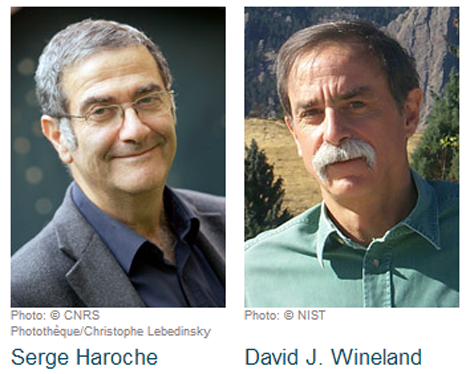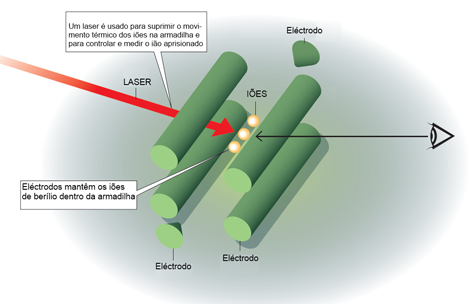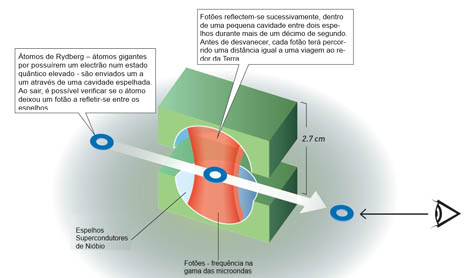 The Nobel Prize in Physics 2012 was awarded to the Frenchman Serge Haroche and the North American David Wineland, “for innovative experimental methods that make it possible to measure and manipulate individual quantum systems”, announced the Nobel Committee.
The Nobel Prize in Physics 2012 was awarded to the Frenchman Serge Haroche and the North American David Wineland, “for innovative experimental methods that make it possible to measure and manipulate individual quantum systems”, announced the Nobel Committee.
The 2012 Nobel Prize in Physics was shared between the Frenchman Serge Haroche and the American David Wineland, for their high-precision experimental work on the control and manipulation of atomic systems.
Serge Haroche, in Paris (France) and David Wineland, in Boulder, Colorado (United States of America) and, according to theoretical physicist Carlos Fiolhais, “have studied the relationship between matter and light: the French made a “box” of light (microwave radiation) into which it throws atoms of matter and the American a “box” of matter, that is, a cavity containing ions (called an atomic “mouse trap”), electrically charged atoms, into which it throws laser light. Thanks to them, changes in an atom corresponding, for example, to the emission or absorption of a single photon (grain of light) can be detected”.
"With these "boxes" it is possible to carry out, on a table, mental experiments that we thought were impossible and that, without exception, have confirmed the quantum theory, today an old lady with more than a hundred years but in excellent health", comments Carlos Fiolhaes.
In fact, before the now awarded inventions, many seemingly bizarre phenomena predicted by quantum physics could not be directly observed.

For nearly eight decades, physicists have only been able to carry out “mental experiments” to investigate the principles that govern the interaction between light particles and matter, in the territory of so-called optical quantum physics.
“The applications of quantum theory – which include X-rays, transistors, lasers, etc. – they are far from being sold out”, exemplifies Carlos Fiolhais.
“The works awarded today, which, despite being related, are independent of each other, have continued and will continue in the direction of applications. They have already made it possible to build the world's most accurate clock: an atomic clock far more accurate than current atomic clocks that travel aboard satellites to give us GPS signals. If such a clock had been running since the beginning of the world, 14 billion years ago, its deviation from the right time would be no more than five seconds. Truly extraordinary! The new instrument relies on energetic “jumps” of atoms when they absorb visible light instead of microwave light, like GPS clocks.”
“One of the dreams of research in this domain is the construction of quantum computers, which will be computers much faster than current ones. The idea of these computers is to do math not with “bits”, which are zeros and ones, but with any intermediate values. Quantum theory works with superpositions of states and the aforementioned experiments allow us to prepare these superpositions”, adds the Portuguese physicist.

For Carlos Fiolhais, “our future will certainly be different thanks to the innovations awarded today. The history of science and technology teaches us. Who knew, in 1901, when the first Nobel Prize in Physics was awarded for the discovery of X-rays, that today X-rays would be so common and would be so useful in our lives? Likewise, just look at the list of Nobel Prize-winning discoveries since that date to see how our lives have been affected: for example, today's computers are based on the transistor, a 1956 Nobel Prize-winning invention, and lasers , which are used everywhere today, are an invention recognized with the 1964 Nobel Prize.”
All these technological applications, which we use in our day-to-day without realizing that they are the result of the application of knowledge arising from the theoretical predictions of quantum physics, were improved through the confirmations provided by the inventions of the now Nobel Prize laureates in Physics. year.
Author Antonio Piedade
Science in the Regional Press – Ciência Viva
Picture's description
Figure 1 - In the laboratory, David Wineland in Boulder, Colorado, electrically charged atoms or ions are held inside a “box” defined by electric fields. One of the secrets behind Wineland's invention is mastering the art of using laser beams and creating very well-controlled pulses of these laser beams. In this device, a laser is used to place an ion in the lowest energy state, which allows the study of quantum phenomena with the ion trapped.
Figure 2 - In Haroche Serge's “light box”, in a vacuum and at a temperature close to absolute zero (0 K or -273, 15 C), microwave photons reflect back and forth inside a small defined cavity. by two mirrors. The mirrors are such that they allow photons to remain for more than a tenth of a second. During this lifetime, long on the quantum scale, many quantum manipulations can be performed with the photon “stuck” and without eliminating it.


















Comments